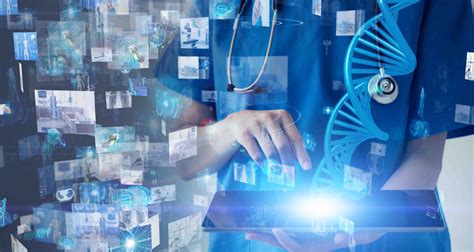How Technology is Revolutionizing the Healthcare Industry

Discover the latest trends in healthcare technology including telemedicine, remote patient monitoring, big data analytics, and robotics in surgery. Learn about healthcare wearables and more.The healthcare industry is constantly evolving, and one of the driving forces behind this evolution is technology. From telemedicine to big data analytics, the integration of technological advancements has revolutionized the way healthcare is delivered and managed. In this blog post, we will explore how technology is reshaping the healthcare industry and the impact it has on patient care, efficiency, and overall outcomes.
Telemedicine has allowed patients to receive medical care from the comfort of their own homes, breaking down barriers to access and improving convenience. Remote patient monitoring has extended the reach of healthcare providers, allowing them to monitor and manage chronic conditions from afar. The use of big data analytics has transformed the way healthcare organizations make decisions and identify trends, ultimately leading to more personalized and effective care. Additionally, the advent of healthcare wearables and robotics in surgery has brought about new possibilities for monitoring and treating patients with increased precision and efficiency. Join us as we delve into the ways technology is shaping the future of healthcare.
Telemedicine
Telemedicine has been revolutionizing the healthcare industry by providing patients with access to medical care from the comfort of their own homes. This technology allows patients to consult with healthcare providers remotely, using video conferencing and other digital communication tools. It has bridged the gap between healthcare professionals and patients, especially for those in rural or underserved areas who may have difficulty accessing traditional healthcare facilities.
One of the key benefits of telemedicine is its ability to improve access to healthcare for individuals who have physical limitations or mobility issues. It also reduces the need for unnecessary in-person visits, saving time and money for both patients and providers. Additionally, the use of telemedicine has been shown to improve patient outcomes and satisfaction, as it allows for more frequent communication and follow-up care.
With the advancement of technology, telemedicine has also expanded to include remote monitoring of patients with chronic conditions. This allows healthcare providers to track and assess patients’ health status in real-time, leading to more proactive and personalized care. As the demand for convenient and efficient healthcare solutions continues to grow, telemedicine is expected to play an increasingly important role in the future of the healthcare industry.
Remote patient monitoring
Remote patient monitoring is a game-changing technology that is transforming the way healthcare is delivered. This innovative approach allows healthcare providers to monitor patients from a distance, using technology to collect and transmit vital health data. By using remote patient monitoring devices, physicians can keep track of a patient’s health status in real-time, allowing for early intervention and personalized care.
In the past, patients with chronic conditions or post-surgery recovery would have to make frequent visits to the hospital or clinic for check-ups. However, with the advent of remote patient monitoring technology, these individuals can now receive continuous monitoring and care from the comfort of their own homes. This has not only improved convenience for patients but also reduced the burden on healthcare facilities, particularly in times of high demand or during public health crises.
With the integration of remote patient monitoring devices and telemedicine platforms, patients have greater access to their healthcare providers and are able to receive proactive and preventive care. This not only improves patient outcomes but also reduces healthcare costs by preventing unnecessary hospital admissions and emergency room visits. The world of healthcare is indeed being transformed by the power of technology, and remote patient monitoring is leading the charge towards a more efficient and patient-centered healthcare system.
Big data analytics
In recent years, the healthcare industry has seen a tremendous transformation due to the implementation of big data analytics. This technology has revolutionized the way healthcare organizations collect, analyze, and utilize data to improve patient outcomes and streamline operations. With the help of big data analytics, healthcare providers can now access valuable insights from vast amounts of data, including patient records, medical imaging, and clinical trials.
One of the key benefits of big data analytics in healthcare is its ability to identify trends and patterns that can help healthcare professionals make more informed decisions. By analyzing large datasets, healthcare organizations can identify risk factors, predict epidemics, and personalize treatment plans based on individual patient data. This has led to improved patient care and better outcomes for individuals with complex medical conditions.
Furthermore, big data analytics has played a crucial role in transforming the business side of healthcare. By analyzing financial and operational data, organizations can identify areas for cost savings, improve resource allocation, and enhance revenue cycle management. This has resulted in improved efficiency and financial sustainability for healthcare providers, ultimately leading to better patient care and outcomes.
Healthcare wearables
Healthcare wearables are revolutionizing the way patients and healthcare providers interact. These devices, which include smartwatches, fitness trackers, and other wearable technology, allow for continuous monitoring of a patient’s health and vital signs. This real-time data can be transmitted to healthcare professionals, allowing for early intervention and personalized treatment plans.
The use of healthcare wearables also empowers patients to take control of their own health. By monitoring their own data, patients can be more engaged in their care and make informed decisions about their wellness. This shift in responsibility can lead to better outcomes and lower healthcare costs in the long run.
Furthermore, the data collected from healthcare wearables can be analyzed using big data analytics to identify trends and patterns in health. This can lead to new insights and advancements in healthcare, ultimately improving patient care and outcomes.
Robotics in surgery
Robotic surgery is a revolutionary advancement in the field of healthcare, with the potential to significantly improve patient outcomes and surgeon performance. The use of robotic technology allows for greater precision, flexibility, and control during surgical procedures, leading to reduced risk of complications and faster recovery times for patients.
One of the key benefits of robotic surgery is the ability for surgeons to perform minimally invasive procedures with enhanced dexterity and visualization. This means smaller incisions, less trauma to surrounding tissues, and ultimately less pain and scarring for the patient. Additionally, the use of robotics in surgery can lead to fewer complications and shorter hospital stays, resulting in reduced healthcare costs and improved overall patient satisfaction.
Overall, the integration of robotic technology in surgical procedures is transforming the healthcare industry by enhancing the capabilities of surgeons and improving the quality of care for patients. As the field continues to advance, we can expect to see even greater innovation and widespread adoption of robotics in surgery, ultimately leading to improved patient outcomes and a more efficient healthcare system.





